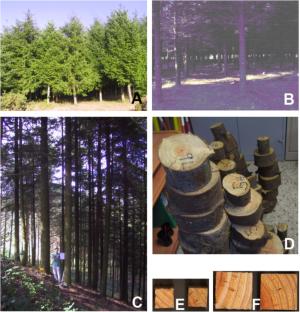Models for predicting physical properties of wood in standing trees are useful for helping to make decisions about tree selection for harvesting and technological use of the material. The objectives of this study were to investigate the variation in physical properties of Douglas fir wood obtained from thinning and to construct a model for predicting wood density on the basis of easy-to-measure properties in thinned trees. Sixteen young Douglas fir trees growing in three stands in Galicia (NW Spain) were felled for the study. Small specimens of defect-free wood were obtained from the trees in order to determine annual growth ring width, density and shrinkage-related properties by standardised testing methods. The sampled wood was homogeneous and light (mean oven-dry density = 429 kg m− 3), and the dimensions were stable in response to changes in moisture content (volumetric shrinkage from saturation to oven-dry state = 12.0%; ratio tangential/radial shrinkage, i.e. anisotropic shrinkage = 1.6). The density of wood in the sampled trees increased with the diameter at breast height and decreased with the height in the stem. The observed significant between-tree and intra-tree variation in wood properties was used to develop a model for predicting oven-dry density, with diameter at breast height and height in the stem as predictor variables (adjusted coefficient of determination = 0.57). The model is useful for estimating wood density along the stem in trees removed during thinning, and the results suggest selecting trees with diameter at breast height over 30 cm when dense wood is needed.




